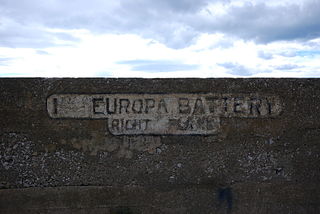
The Line Wall Curtain is a defensive curtain wall that forms part of the fortifications of the British Overseas Territory of Gibraltar.

The South Bastion was part of the fortifications of Gibraltar, protecting the western base of the Charles V Wall. It was originally built by Spanish military engineers, later improved by the British. The South Bastion stands at the south end of the Line Wall Curtain which defends the town from attack from the Bay of Gibraltar. Another curtain wall runs east from the bastion to the base of a precipice. This wall is pierced by the Southport Gates, guarded by the South Bastion and the Flat Bastion on either side.

The Moorish Wall, also known as the Philip II Wall and formerly the Muralla de San Reymondo is a defensive curtain wall built in the 16th century that formed part of the southern fortifications of the British Overseas Territory of Gibraltar. It was completed by 1575. The wall ran from the top of a steep cliff above the lower section of the Charles V Wall up the slope of the Rock of Gibraltar to its crest, north of the upper section of the Charles V Wall and is now within the Upper Rock Nature Reserve.

The North Bastion, formerly the Baluarte San Pablo was part of the fortifications of Gibraltar, in the north of the peninsula, protecting the town against attack from the mainland of Spain. The bastion was based on the older Giralda tower, built in 1309. The bastion, with a mole that extended into the Bay of Gibraltar to the west and a curtain wall stretching to the Rock of Gibraltar on its east, was a key element in the defenses of the peninsula. After the British took Gibraltar in 1704 they further strengthened these fortifications, flooding the land in front and turning the curtain wall into the Grand Battery.

The Gibraltar Heritage Trust is a non-profit charity established by statute on 1 May 1989 to preserve and promote the cultural natural heritage of the British Overseas Territory of Gibraltar.

Wellington Front is a fortification in the British Overseas Territory of Gibraltar. It was built in 1840 on a site established by the Spanish in 1618.

Couvreport Battery is an artillery battery in the British Overseas Territory of Gibraltar.

The Europa Batteries are a group of artillery batteries in the British Overseas Territory of Gibraltar. Facing the North African coast, they are the most southerly batteries in Gibraltar and were built to cover ships approaching from the Mediterranean Sea. They run along the fortified clifftops of Europa Point from Camp Bay on the west side of the Rock of Gibraltar to the Europa Advance Batteries on the east side.

Genoese Batteries are a pair of artillery batteries in the British Overseas Territory of Gibraltar. The Upper and Lower Genoese Batteries defended the south front of Gibraltar together with the Flat Bastion, South Bastion, Prince Ferdinand's Battery and Healy's Mortar. They were originally built by the Moors or Spanish but added to by the British in the 18th century.

Jones' Battery is one of the best preserved of the "retired" artillery battery in the British Overseas Territory of Gibraltar. It was named after Sir John Thomas Jones who once controlled the fortifications here.

Raglan's Battery was an artillery battery overlooking the harbour in the British Overseas Territory of Gibraltar. During World War II the Raglan Battery Shelter was here.

The Rosia Batteries are a group of artillery batteries in the British Overseas Territory of Gibraltar.

Europa Advance Batteries were a group of three artillery batteries in the British Overseas Territory of Gibraltar. They are located north east from Europa Point.

Civil Hospital Battery was an artillery battery in the British Overseas Territory of Gibraltar.

Cumberland Flank Battery was an artillery battery in the British Overseas Territory of Gibraltar.

Devil's Bowling Green Battery was an artillery battery in the British Overseas Territory of Gibraltar. In 1859 the battery had two guns that looked over Little Bay. This battery was on the shoreline but it was overlooked by the Buena Vista Battery and the seven guns of the Europa Pass Battery

Half Way Battery was an artillery battery in the British Overseas Territory of Gibraltar. The battery was on the coast on the eastern side of the isthmus just north of Europa Point Lighthouse. In 1859 there were two guns.
Lady Augusta's Battery was an artillery battery in the British Overseas Territory of Gibraltar.
Prince of Wales Battery is an artillery battery in the British Overseas Territory of Gibraltar.

Woodford's Battery was an artillery battery in the British Overseas Territory of Gibraltar. It is located at Europa Flats between the Defensible Barracks and the Officer's Barracks and Eliott's Battery.












